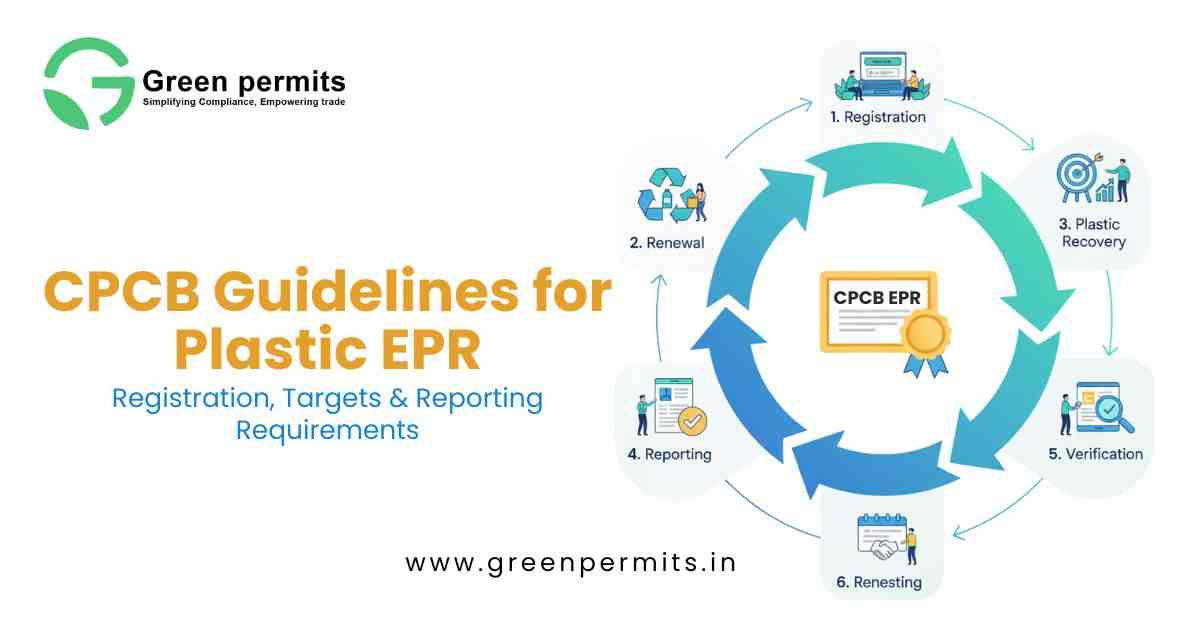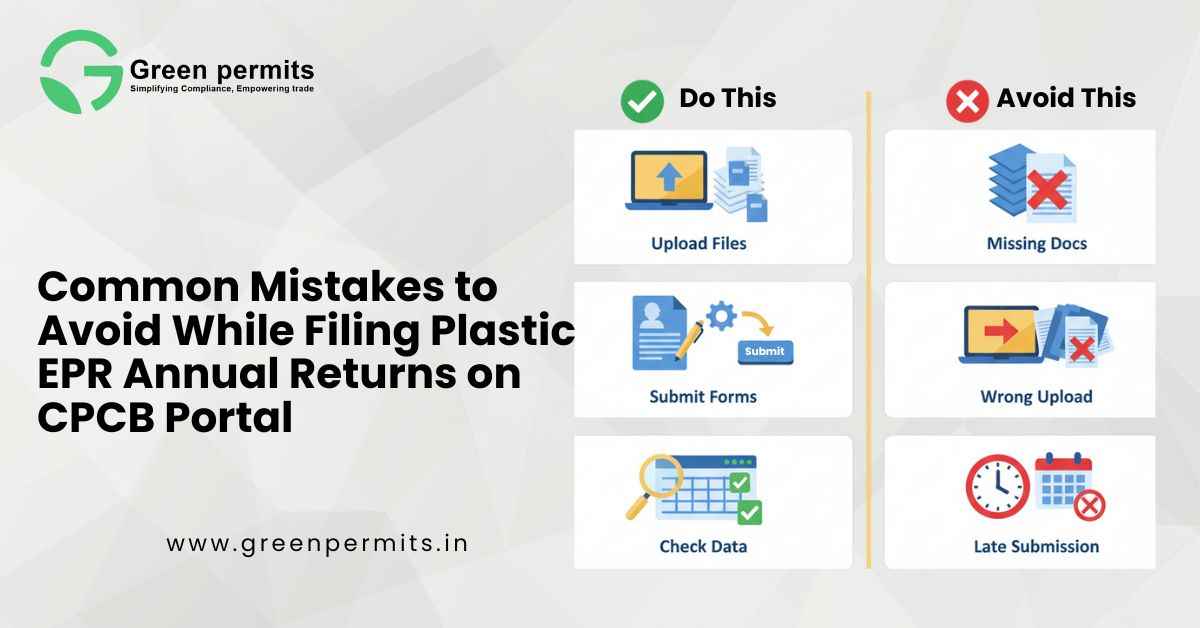When Rajesh, a packaging manufacturer in Gujarat, logged into the CPCB portal, he noticed something new — a notification about printing QR codes on every plastic wrapper. Until then, his team had focused mainly on filing returns. But from mid-2025, packaging design itself would need compliance built in.
If you are a business owner, importer, or brand owner handling plastic packaging, these changes under the Plastic Waste Management (Amendment) Rules, 2025 directly affect you. This guide breaks down everything — registration, targets, reporting, and what’s new this year — in simple business language.
Understanding Plastic EPR and CPCB’s Role
Extended Producer Responsibility (EPR) is the cornerstone of India’s plastic waste regulation. It means that whoever places plastic packaging into the market — whether a manufacturer, importer, or brand owner — is also responsible for ensuring that equivalent quantities are collected, recycled, or co-processed later.
The Central Pollution Control Board (CPCB) operates India’s national Plastic EPR Portal, where all compliance activities take place. This includes:
- Registering entities as PIBOs (Producers, Importers, Brand Owners)
- Approving Plastic Waste Processors (PWPs)
- Tracking recycling targets
- Auditing returns and issuing environmental compensation notices
For businesses, the portal is both a compliance tool and a proof of environmental responsibility.
Who Needs EPR Registration and Why
If you produce, import, or sell goods in plastic packaging, you are required to register under the CPCB’s centralized EPR system.
Who Must Register
- Producers manufacturing plastic packaging or using it to sell goods.
- Importers bringing in packaged products or packaging material.
- Brand Owners selling goods under their brand name in plastic packaging.
- Online sellers or e-commerce brands using plastic as part of distribution.
Operating without registration can lead to rejection of tenders, blockage of sales on e-commerce platforms, and penalties under environmental law.
How to Register on the CPCB EPR Portal
The registration process has been standardized to make compliance transparent and fully online.
Step-by-Step Overview
- Create an account on https://cpcbeprplastic.in.
- Enter business details – PAN, GST, CIN, IEC (if importer), and contact information.
- Upload documents – consent certificates under the Air and Water Acts, process flow diagrams, and self-declarations.
- Provide authorized signatory details – name, designation, Aadhaar, PAN, and contact number.
- Submit application and pay the applicable fee through the payment gateway.
- Check status – CPCB reviews applications within 15 working days.
If the application is incomplete, a digital checklist appears in your dashboard. Once verified, the certificate is auto-generated with a unique EPR Registration Number valid for five years.
Key Documents Required
- Company PAN, GST, and CIN certificate
- IEC (Import Export Code) for importers
- Consent to Operate (CTO) and Consent to Establish (CTE)
- Process flow diagram for production
- CA-certified sales data in tonnes
- Self-declaration of RoHS and waste management practices
Businesses should ensure that all addresses in GST, consent certificates, and registration forms match exactly — mismatched data is a common reason for rejection.
EPR Targets and How They Work
EPR targets define how much plastic waste a business must recycle or process each year. The portal auto-calculates your obligation based on sales data from previous years.
How Targets Are Calculated
Let’s say your company introduced 100 tonnes of plastic packaging in FY 2024–25. With a 50% EPR target, you must ensure that at least 50 tonnes are recycled or co-processed through CPCB-registered Plastic Waste Processors (PWPs).
Targets are divided into:
- Recycling obligations — actual recovery of plastic waste.
- Use of recycled content — incorporating recycled plastic back into packaging.
- End-of-life disposal — co-processing or waste-to-energy routes.
Indicative EPR Targets
| Financial Year | Minimum Recycling Target | Minimum Recycled Content in Packaging |
|---|---|---|
| 2023–24 | 30% of plastic introduced | 10% |
| 2024–25 | 50% | 20% |
| 2025–26 & beyond | 60–80% (depending on plastic type) | 25–30% |
These percentages vary by category — rigid plastics, multilayered packaging, compostable plastics, and single-use items each have different thresholds.
The 2025 Update: QR Codes, Barcodes & Traceability
The latest amendment to the Plastic Waste Management Rules, effective 1 July 2025, makes packaging traceable to the source.
What Changes
- Every PIBO must print a barcode or QR code containing its EPR Registration Number.
- The code can appear on the packaging, on the equipment containing the packaging, or on product brochures.
- Producers must notify CPCB of which option they choose.
- CPCB will publish a quarterly list of all registered PIBOs who have complied.
This move eliminates ambiguity and allows regulators to track plastic right from manufacturing to post-consumer waste. It also helps consumers verify legitimate, registered brands.
Return Filing and Annual Reporting
Compliance doesn’t end with registration. Every PIBO must report progress on its EPR targets quarterly and annually through the portal.
Quarterly Returns
- Filed every three months to record waste processed and certificates purchased.
- Not mandatory for awareness activities but recommended.
Annual Return
- Due by 30 June of the following financial year.
- Must include awareness initiatives, proof of recycling, and all EPR certificates purchased.
- Requires uploading of supporting documents and audited data.
A company that misses deadlines risks environmental compensation charges and difficulty in renewing registration.
Simple Example
If a beverage company introduced 200 tonnes of plastic packaging in 2024–25 and recycles 120 tonnes via CPCB-approved recyclers, it fulfills 60% of its target. The remaining 40% must either be met by purchasing recycling certificates or carried forward as a shortfall.
Penalties and Consequences of Non-Compliance
Non-compliance under EPR rules is no longer a minor administrative issue — it’s treated as an environmental violation.
Possible Penalties
- Environmental Compensation (EC): CPCB can impose monetary penalties for delays or shortfalls.
- Suspension of registration: Persistent non-filing can lead to suspension of your EPR certificate.
- Fines under the Environment (Protection) Act, 1986: For serious violations, penalties include imprisonment up to five years or fines extending to several lakhs.
CPCB also publishes defaulter lists and blocks renewal applications until all pending obligations are cleared.
What Businesses Should Do Now
- Verify your CPCB registration – ensure your EPR certificate is active and visible on the CPCB list.
- Redesign packaging – integrate QR or barcode with EPR number before July 2025.
- Partner with authorized recyclers or PWPs – track waste quantities digitally.
- File returns on time – quarterly and annual filings are mandatory.
- Maintain documentation – CA certificates, invoices, and recycling proofs should be easily accessible for audit.
- Plan awareness programs – these improve credibility and demonstrate corporate responsibility.
Why Proactive Compliance Matters
EPR compliance is not just about avoiding penalties. It can:
- Build trust with retailers and distributors who now prefer compliant suppliers.
- Enhance brand reputation among eco-conscious consumers.
- Improve operational transparency through traceable packaging.
- Open doors for government tenders and export opportunities that require sustainability credentials.
In short, compliance today is smart business tomorrow.
Conclusion
The new CPCB guidelines mark a major shift from manual paperwork to digital accountability. With QR-coded packaging, real-time reporting, and higher recycling targets, plastic EPR is becoming a central part of India’s sustainability roadmap.
Whether you are a large manufacturer or a growing startup, getting your EPR process right means smoother audits, cleaner records, and stronger credibility in the market. Partnering with experts can help you avoid errors and stay future-ready.
📞 Get Expert Help with EPR Compliance
Call: +91 78350 06182 | Email: wecare@greenpermits.in
Book a Consultation with Green Permits — Your Trusted Partner for Plastic EPR and CPCB Registration.
Book a Technical Call with Expert
FAQs
All Producers, Importers, and Brand Owners introducing plastic packaging into the Indian market must register on the CPCB portal.
Between 60% and 80% of plastic introduced must be recycled or co-processed, depending on packaging type.
Mandatory QR or barcode printing of EPR Registration Numbers on all packaging from 1 July 2025 and quarterly publication of compliant entities by CPCB.
By 30 June each year for the previous financial year, filed through the CPCB EPR portal.
It can face Environmental Compensation, suspension of registration, or penalties under the Environment (Protection) Act.



